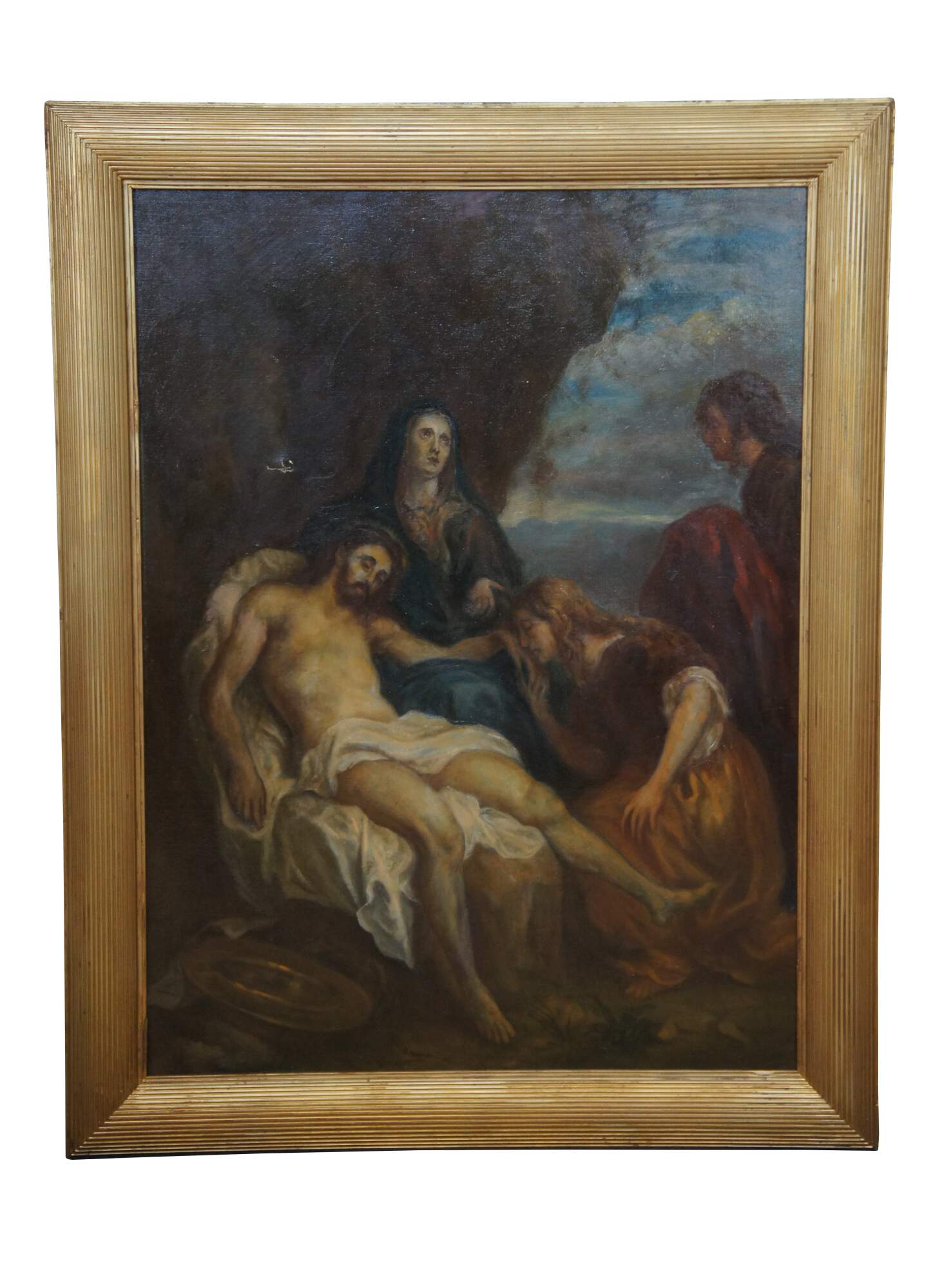
Shipping:
Free Shipping Included
Delivery:
Estimated 2-15 Business Days
Payments:
Credit Card, Check, Cash, PayPal, Apple Pay, Venmo
Returns:
30 Days 100% Money Back Guarantee, Buyer Pays Return Shipping
Description
Oil on canvas ""The Lamentation"" painted after the original (ca. 1629) by Sir Anthony van Dyck. This rendition of the burial of Jesus Christ shows the Virgin Mary holding her son in her arms and looking toward heaven, while Mary Magdalene kisses his hand and St John the Evangelist looks on. Unsigned. Circa late 18th/ early 19th century
“Pietà, as a theme in Christian art, depiction of the Virgin Mary supporting the body of the dead Christ. Some representations of the Piet� include John the Apostle, Mary Magdalene, and sometimes other figures on either side of the Virgin, but the great majority show only Mary and her Son. The Piet� was widely represented in both painting and sculpture, being one of the most poignant visual expressions of popular concern with the emotional aspects of the lives of Christ and the Virgin.
The theme, which has no literary source but grew out of the theme of the lamentation over Christ’s body, first appeared in the early 14th century in Germany. It soon spread to France and enjoyed great popularity in northern Europe in the 14th and 15th centuries. Although the Piet� remained mostly a Franco-German theme, its supreme representation is that completed by Michelangelo in 1499 and housed in St. Peter’s Basilica in Rome. Influenced by the northern style, Michelangelo draped the figure of Christ across Mary’s lap. Through this pyramidal design and the details of his figures, Michelangelo created a scene that displayed at once agony, solemnity, and heroic resignation.
The format of the Virgin bearing the body of Christ on her knees was standard until the 16th century, when, influenced by the Renaissance concern with logic and proportions, artists usually depicted Christ lying at the Virgin’s feet, with only his head propped against her knees. This form was adopted by Italian Baroque art and was passed on to Spain, Flanders, and Holland.
Most religious art suffered a decline after the 17th century, but, because of its special emotional appeal, the Piet� continued to be a vital theme through the 19th century.”
“Sir Anthony van Dyck (Dutch pronunciation: [vɑn ˈdɛik], many variant spellings;[1] 22 March 1599 – 9 December 1641)[2] was a Flemish Baroque artist who became the leading court painter in England after success in the Spanish Netherlands and Italy.
The seventh child of Frans van Dyck, a wealthy Antwerp silk merchant, Anthony painted from an early age. He was successful as an independent painter in his late teens, and became a master in the Antwerp guild in 1618. By this time he was working in the studio of the leading northern painter of the day, Peter Paul Rubens, who became a major influence on his work.
Van Dyck worked in London for some months in 1621, then returned to Flanders for a brief time, before travelling to Italy, where he stayed until 1627, mostly in Genoa. In the late 1620s he completed his greatly admired Iconography series of portrait etchings, mostly of other artists. He spent five years in Flanders after his return from Italy, and from 1630 was court painter for the archduchess Isabella, Habsburg Governor of Flanders. In 1632, he returned to London to be the main court painter, at the request of Charles I of England.
With the exception of Holbein, van Dyck and his contemporary Diego Velázquez were the first painters of pre-eminent talent to work mainly as court portraitists, revolutionising the genre. He is best known for his portraits of the aristocracy, most notably Charles I, and his family and associates. Van Dyck became the dominant influence on English portrait-painting for the next 150 years. He also painted mythological and biblical subjects, including altarpieces, displayed outstanding facility as a draughtsman, and was an important innovator in watercolour and etching.
His influence extends into the modern period. The Van Dyke beard is named after him. During his lifetime, Charles I granted him a knighthood, and he was buried in St Paul's Cathedral, an indication of his standing at the time of his death.”
Condition
Good Overall - Gentle wear overall; couple of patches/repairs; one un-restored tear
Dimensions
41.5” x 1” x 53.5” / Sans Frame - 33.5” x 45.25” (Width x Depth x Height)